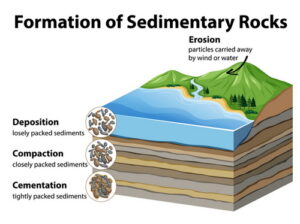
The sediment, made up of sand, mud, and pebbles, constitute sedimentary rocks, which develop from other rocks that have been worn down by the environment over the years.
To determine the age of the layers of rocks that have accumulated over the millions of years on our planet, we need to look at sedimentary rocks, which are accumulations of rock sediments.
There are three basic types of sedimentary rocks:
Clastic sedimentary rocks
Breccia, conglomerate, sandstone, siltstone, and shale are formed from mechanical weathering debris.
Chemical sedimentary rocks
Rock salt, iron ore, chert, flint, dolomites, and limestone form when dissolved minerals precipitate from the solution.
Organic sedimentary rocks
Coal, some dolomites, and some limestones form from plant or animal debris accumulation. More specifically, several processes are involved in the formation of sedimentary rock:
Weathering (aka erosion)
Which results from the friction of waves, transportation, where the sediment is carried off by a current, and deposition and compaction, where the sediment is flattened.
Lithification (aka rock formation)
Lithification develops as the sediment pressure squeezes the sediment into layered solids. By reviewing the different layers of sediment, scientists can tell when rock formations and minerals began to materialize.
